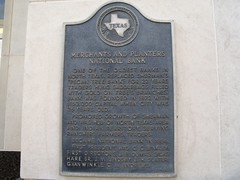
Town of Pettus. Oil capital of Bee County, Pettus was settled in the 1850's when John Freeman Pettus set up his sprawling ranch about 4 miles south of here. The son of one of Stephen F. Austin's first 300 colonists, Pettus was an extensive cattle and horse breeder. The town, previously called "Dry Medio" for a nearby creek, was named for him during the Civil War. The community was in the vicinity of two important Indian skirmishes in Bee County in 1859 and the 1870's; but the town slept until 1886, when the tracks of the San Antionio & Aransas Pass railroad reached this site. It then awoke to become the cattle shipping center for the area. In the same year, John S. Hodges, a pioneer citizen, laid out the townsite and donated land to be used for streets and S.A. & A.P. right-of-way. For years the railroad stockyards and depot were places of bustling activity as freight trains came for loading and wood-burning steam engines took on water. In 1909 the presidential train of Wm. H. Taft stopped at the Pettus water tank. The tank--a final monument to steam railroading here--was razed, 1965. In 1929 the Houston Oil Co. brought in its well "No. 1-Maggie Ray McKinney" and from that time Pettus has played a continuing useful role in Texas economy. (1968) #5536
by Texas Historical Commission #05536 of the Texas Historical Marker series
Colour: black
Wikimedia:
Flickr:


